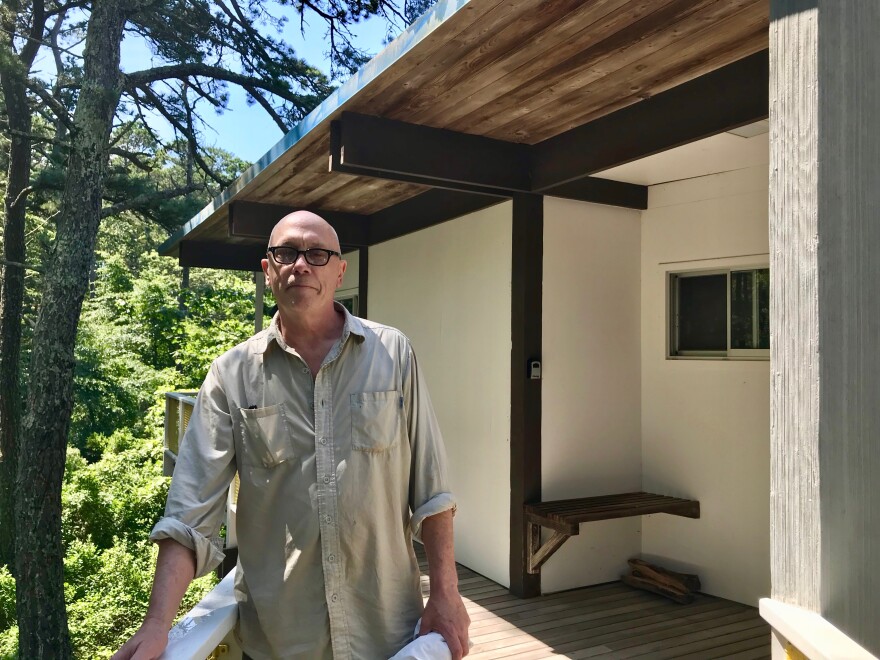Say the phrase “Cape Cod house,” and most people picture a quaint, grey-shingled cottage. But deep in the woods of Wellfleet, a group of outliers defy that stereotype. These are modern homes built by a group of bohemian designers who gravitated to the area in the 1930s and 40s and pioneered the school of modern architecture. Several of these houses have been restored by the Cape Cod Modern House Trust, which offers tours of the homes during summer.

“A group of American self-taught architects came to Wellfleet and started homesteading and building their own version of modern architecture,” said Peter McMahon, who founded the Cape Cod Modern House Trust in 2006. “They hadn’t gone to architecture school, so this was sort of like a naïve version of modern architecture that they had seen in Europe.”
These American designers became friends with a group of European designers who were emigrating to America during the run-up to World War Two – people like Walter Gropius, Marcel Breuer and others, many of whom began teaching architecture at Harvard. They focused on the Bauhaus curriculum, a school of architecture that tried to reconcile mass production with handcraft. The Bauhaus movement was founded in 1919 and lasted a mere 13 years, but it would heavily influence the design of many of the Outer Cape’s modern houses, like the Kugel-Gips house.
“This house was empty for 11 years. The roof failed. There were animals living in here. The decks had rotted all the way through. So this was a real ruin when we got it,” said McMahon.
When the Cape Cod National Seashore was enacted in 1961, the Park Service froze all development within its boundaries.

“Often, when you see historic houses, everything’s changed around them. And this is pretty much, what you see is what they saw when they built them,” said McMahon.
Wellfleet’s modern architects were bohemians who hung out together, skinny-dipped, and went to cocktail parties at each other’s houses. Everyone knew each other.
The modern architecture trend continued into the 50s and 60s. But by the late 1960s and early 70s, modernism began to fall out favor.
“It was a small avant-garde movement, and then it was adopted by corporate America. So you had high-rises that were all glass. It wasn’t bohemian any more. And then, in the student uprisings in the 60s, basically it was a new generation and they rejected modernism as part of the military-industrial complex,” said McMahon.
These trend-setting buildings eventually became excess structures in the Cape Cod National Seashore. They were bought up and set for demolition. But budget cuts prevented that from happening in every case, and some were simply left to the elements.
By the mid-2000s, a renewed appreciation for modern architecture prompted the Cape Cod Modern House Trust to begin restoring several of these classic structures. The Park Service now leases the homes to the Trust, which rents them out in summer and makes them available to visiting scholars in Spring and Fall.

The Hatch House sits on a bluff overlooking Cape Cod Bay. It’s a group of cube-like structures built in sections and connected by walkways. There’s a spacious living room and several bedrooms with spartan furnishings, like bunks at a summer camp. Of the three modern houses the Trust has restored, the Hatch house is the only one with its original furnishings.
“When Cape Cod Modern House Trust came in a re-did the house, the family gave the furniture back to the house,” said Betsy Bray, a volunteer tour guide for the Trust.

The Cape Cod Modern House Trust tours have become extremely popular – they’re sold out for the rest of the summer.
“It was just an incredible time because the post-war building boom was just sort of a moment of opportunity. People now look back at this as a golden era of American design,” said McMahon.
The Cape Cod Modern House Trust will begin taking reservations for 2019 tours next Spring. You can find more information at ccmht.org.







